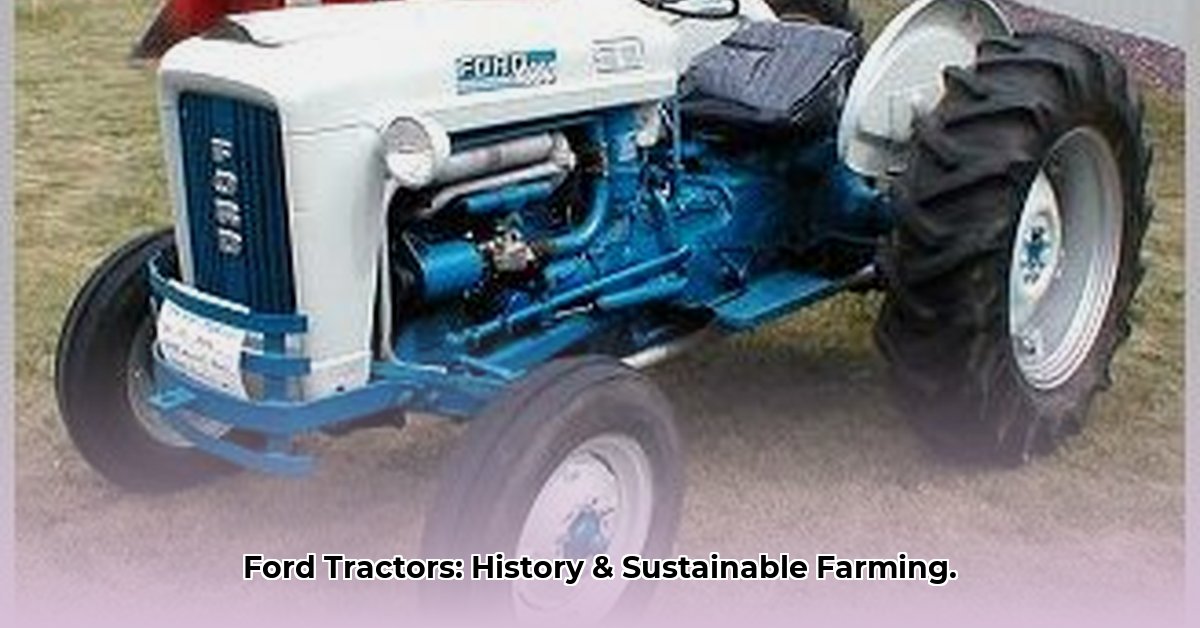
This guide explores the rich history of Ford tractors and their surprising relevance to modern sustainable farming. We'll examine various models, highlighting their strengths and weaknesses from an environmentally conscious perspective. This isn't about replacing modern tractors, but about finding viable, sustainable alternatives where they fit best. For more images, see these Ford tractor photos.
A Blast from the Past: Early Ford Tractors (Fordson)
The legendary Fordson tractor revolutionized farming. Its simple, rugged design ensured reliability. However, fuel efficiency and parts availability present challenges for modern sustainable farming. The simplicity that made it a workhorse also makes finding parts today difficult.
(Insert image of a Fordson tractor here)
This image exemplifies the Fordson's robust yet straightforward design. While durable, it lacks the fuel efficiency of modern tractors, raising questions about its long-term sustainability. Is the environmental impact of its fuel consumption worth the simplicity and reliability?
Mid-Century Icons: The Ford 8N and 9N
The Ford 8N (1947-1952) and 9N (1939-1947) became iconic symbols of American agriculture. Their increased power and efficiency compared to earlier models significantly impacted food production. But, their engine technology is less environmentally friendly by today's standards. Higher fuel consumption and potentially greater greenhouse gas emissions remain significant considerations.
(Insert image of a Ford 8N or 9N tractor here)
This photo shows the 8N's streamlined design compared to the Fordson. While more efficient, fuel consumption data remains a crucial factor in assessing their modern sustainability. Can we accurately quantify their environmental effects to contrast them with newer technologies?
Later Models: Bridging the Gap (1960s-1970s)
Later Ford tractors represent a transition period, blending older designs with emerging technologies. While they offered improvements, they often lacked the advanced features and fuel efficiency of contemporary machines. Parts availability and repair costs also vary significantly depending on the model and its age.
(Insert image of a later Ford tractor model, perhaps a 1960s or 70s model here)
This image shows the design evolution. However, maintaining these tractors can be challenging, with parts sourcing and repair costs potentially outweighing the benefits for some farmers. How do these factors impact long-term sustainability?
Sustainability Considerations for Older Ford Tractors
Older Ford tractors present both opportunities and challenges for sustainable farming. Parts availability is a key concern. The difficulty in acquiring parts can lead to premature disposal, increasing waste. Additionally, lower fuel efficiency leads to higher operating costs and a larger carbon footprint. However, some models can be converted to run on biofuels, a significant pathway to greater sustainability. Proper maintenance is crucial to extend their lifespan.
Does the effort required to maintain an older Ford tractor outweigh the environmental benefits?
Choosing the Right Ford Tractor: A Practical Checklist
Selecting a Ford tractor for sustainable farming depends on several factors:
- Task Suitability: Can the tractor handle the specific farming tasks required?
- Fuel Economy: How does its fuel consumption compare to modern options? Are biofuel conversions feasible?
- Maintenance & Repair: Are parts readily available? How complex are repairs?
- Environmental Impact: Evaluate the tractor's complete life cycle, from manufacturing to disposal.
Carefully weighing these factors is crucial for making an informed and sustainable choice.
Modern Applications and Adaptations
While initially designed for different agricultural practices, older Ford tractors can adapt well to sustainable farming. Their simplicity reduces reliance on complex supply chains and the overall reliance on external support.. Older tractors could fit small-scale operations and those valuing a hands-on approach. Furthermore, communities of enthusiasts can offer valuable support.
Conclusion: Sustainable Farming and the Legacy of Ford
Ford tractors hold a significant place in agricultural history. Their continued role in modern sustainable farming needs careful consideration. Assessing both the advantages and disadvantages of integrating these classic machines requires a balanced look. By exploring innovative solutions and carefully evaluating their limitations, we can determine how these iconic machines can contribute to the future of sustainable agriculture. The ongoing research and shared experience will help shape environmentally conscious farm practices.